Wave (2008)
If there is one book that we could claim has catapulted Suzy Lee to fame, it would be her wordless picture book Wave which has earned a starred review from Kirkus Reviews describing it as “simply spectacular”; a starred review from School Library Journal depicting it as “A simple, well-crafted story of friendship” and also a starred review from Publisher’s Weekly who noted that this is “A book whose rewards multiply with rereading” – and glowing reviews as well from The Wall Street Journal, The New York Times Book Review, Scholastic Parent & Child among others.
It has also been selected as one of the year’s 10 Best Illustrated Children’s Books by the New York Times in 2008, a Gold Medal from the Society of Illustrators Original Art 2008, Best Books of the Year, Children’s Picture Books by Publisher’s Weekly, School Library Journal Best books of 2008, and Scripps Howard News Service Favorite Children’s Books of 2008.

I am a water-person. I love hearing the sound of the waves as they lull me to sleep, I love looking at the movement of the ocean and feeling the sand on my feet. Staring at the artwork in Wave, I can almost hear the distinct crash of the waves as the charcoal-rendered little girl alternately plays with and gets frightened by it. Her exuberance and attempts to show the ocean waves who’s boss around the shoreline culminate with her getting beautifully soaked to the skin and her thanking the waves (both hands outstretched on the ocean bed) for the bounty that it has shared with both the girl and the seagulls.

In A Conversation with Suzy Lee by Chronicle Books (CB), Suzy talks about creating a picture book without words, the inspiration behind Wave, and the storyline behind the artwork. I know that you have answered quite a few questions about Wave, and I know that some of my questions would be an inevitable duplication, but I hope that you’d bear with us as we explore the concept behind wordless art.

Wave (Q & A with Suzy Lee)
Our Bimonthly theme right now in GatheringBooks is “When Words are Not Enough” – can you share with us the magic behind wordless art in picture books for children, what do you think makes it so powerful?
When you read a wordless picture book, obviously there are only images- you don’t hear any words. If you can hear something, it’s just the sounds of waves and seagulls and the voice of the inner child of your mind splashing in the sea. Every details of the story comes from your mind, not from outside. The author starts the story, but it’s you who fill the gap and complete the story. Since there’s no fixed direction to read through, there are lots of possibilities to read it in your own way. When you close the book, I am sure that you have experienced something quite different.
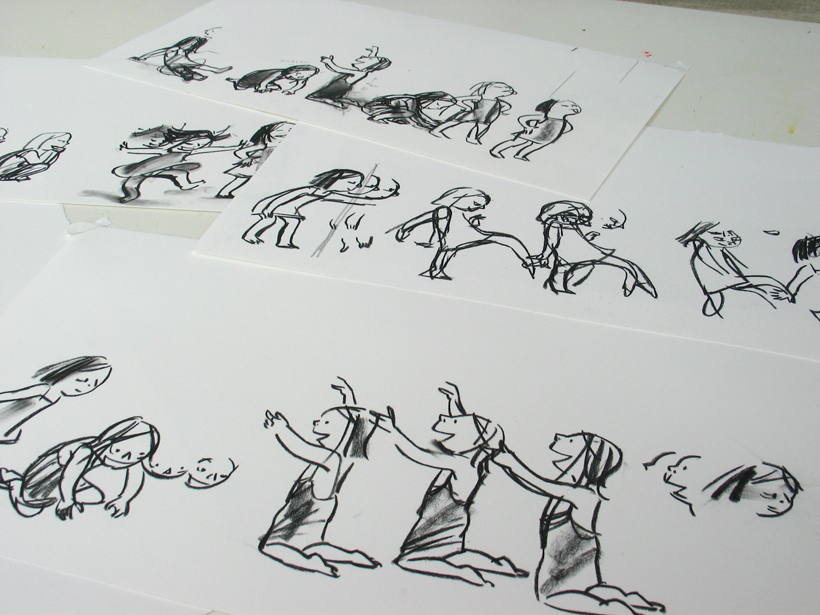
Did you have a specific beach in mind as you were creating Wave? What is the story behind the creation of this fantastic book?

I had good childhood memory of the beach in West Sea of South Korea that our family used to visit every summer. When I made “Wave”, I was living in Houston, Texas, U.S.A. and me and my husband often went to the Galveston beach to do sketching near Houston. Wherever I go, there’s always this common sight that children and grown-ups alike play the game with the waves chasing each other. I found it very interesting and I thought, some day, I would make a book about this universal scene.
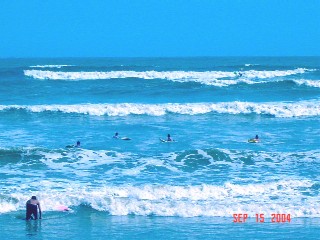
I particularly like the part when the little girl stretches out her hand and gets cut by the book-gutter; very much like you said – sort of like Alice coming out of the mirror in Through the Looking Glass. In the interview done by Chronicle Books (CB), you mentioned the significance of the book gutter as you designed and conceptualized Wave, could you share with our GatheringBooks readers some of your thoughts on this? Could you also share with us what you mean when you talked about this “psychological line in the girl’s mind” in the interview with CB.
As a book artist, I am very interested in creating a book which is possible because it takes the form of the book. There are many interesting aspects that the book as an object naturally innate. I focused on “the border” between the two facing pages of the book, the center binding line. What if I use this gutter intentionally to make a story? And this center fold seems to be perfect to work as a border of fantasy and reality, which the child goes through in “Wave”. There are two worlds divided by this border in “Wave”. The left hand-side represents the real world and the right hand-side represents the wave’s world. In order to get into the fantasy, you need to cross over this border- the child is literally absorbed into the center, and then comes out of it. Now, something’s been changed.
Psychological line in girl’s mind? “To be soaked or not to be soaked, that’s the question.” You should decide if you’re going to get wet or not in order to achieve something – there’s always the choices you have to make at some point.

The elemental power of nature and the unspoken bond between the little girl and the birds are quite strong in Wave, is this influenced in part by your own exposure with the natural elements when you were growing up?

As I see the recent nuclear crisis caused by the earthquake in Japan, I cannot help thinking that we-human-are real problematic existence in the point of the living things of the earth. Nature is still and stays its own path. Maybe that’s the way I see the relationship between nature and us: we need to respect and leave each other in a certain distance away. (If you look at the child and the seagulls, they maintain some distance as they move.)
Would you say that the wordless quality of Wave is instrumental in its being an international success? I personally feel that the absence of words serve to make the book accessible to people who have different cultural realities (with different languages and socio-historical background) – was that a consideration why you make a point to make your books wordless in nature?
I have received quite a few emails from the readers of different countries and different age groups. (In particular, “Wave” is very popular among the grandfathers. Interesting.) And the readers responded that they think that it’s made for them, wherever they are living. I also eagle to find out what it is that make us all connected. I didn’t plan it, but I agree that one of the reasons why “Wave” is popular may be because it’s wordless. Since there are no words to explain or help the narrative, you constantly check if I properly communicate with readers through the universal codes of images.
Mirror (2003)

Mirror begins as a lighthearted, seemingly-innocuous book about a girl playing with her own reflection in the mirror. It brought loud guffaws of laughter from me mid-way and it has also made me choke back unbidden tears in the end. It is that powerful in evoking such a roller-coaster of emotions without the book even saying a word. Suzy Lee simply stands as a league of her own – nothing comes close to this.
In a wordless picture book such as this, nothing is superfluous – everything about the book: its length, width, spaces in between signify something important to the narrative that is communicated exclusively through images and color. In Mirror, we

are introduced to a sad little girl who seemed surprised at seeing her reflection in the mirror. The folds of the pages – the book gutter functions as the invisible mirror that allowed the little girl to make faces, hide, and play coy at her own reflection.
Something surreal happens midway, though, when the two figures collided and somehow merged into the other – the boundaries between fantasy and reality blurring as the girl now seemed unable to get her mirror-image to do what she desires. The academic in me now can not seem but wax lyrical about possible philosophical/existential issues that could be raised with this book as one struggles with the difficulty in reconciling what ought to be with what really is as one stares at one’s own reflection. Its poignant and seemingly-deafening silence as you flip through the pages contributes even more to its magical, surreal yet hauntingly-real quality.
Mirror (Q & A with Suzy Lee)
Suzy, in this interview with Taiwan dpi Magazine, you talked briefly about Mirror and you mentioned that it took only a week for you to complete this from a casual idea to a finished book, could you share with us what made this book a quickly-realized creation?
The idea was simple, and it was realized in a very simple manner too. It was a kind of the moment of “Eureka!” as if I found some truth of the “bookness”. I was just excited that those facing pages in a book can work like a mirror, and I immediately drew the first image that popped up in my head. The mirror is to be broken; the conclusion came to me naturally. I didn’t try to revise the story nor the images because it seemed that the story fit perfectly in its concept.
I make a joke all the time about the quick-process of making images: I drew the girl and used the same image in the mirrored-page by simply flipping it horizontally in Photoshop. What a time-effective way of working process!
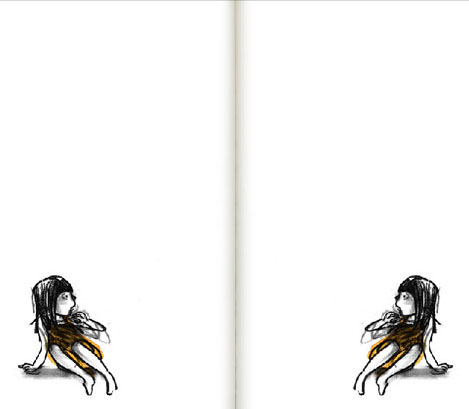
In the interview with the Taiwan magazine, you noted that you are interested in the concept of “what makes a book to be a book?” thus you made full use of the book gutter as an important element in the wordless narrative, something which is also evident in Wave. Could you tell our GatheringBooks readers more about this?
“A book is a set or collection of written, printed, illustrated, or blank sheets, made of paper, parchment, or other various material, usually fastened together to hinge at one side.” This is the definition by the dictionary. This sounds quite boring but if we peer into the elements carefully one by one, there are so many interesting facts. This “book” is the medium that I use to convey my ideas. Therefore, I have to figure out first what it is. What is a book? This question leads me the next question. “What makes a book to be a book?” And I put all the characters and elements of the physical book on trial.

There is a haunting quality to Mirror that would resonate not only with very young children, but with teenagers and even adults as well – what are your thoughts on this?
My books are usually categorized as “for all ages”. That encourages me a lot that my trials are accepted one way or another. I would like to make a book with many layers so that it can appeal to various readers. Especially, “Mirror” has wider spectrum because the story is somehow vague and strange. Grown-ups read it as “we are all alone” and teenagers interpret the book as their adolescent growing-pain. Very young children? They simply say, “A bored girl had a fight with her dear friend and she got bored again.” Marvelous.

I noted that you like playing with boundaries, the edges of what could be, and breaking unbidden frames and barriers of what constitutes a ‘book’ or what makes up ‘reality.’ Could you tell us a little more about this? How has the wordless quality of your books contributed to this interest of yours?
Readers see the story of the border of fantasy and reality through my books, and at the same time, feel the physical border of the book. Reality comes in that manner. Everything happens at the same time. If there’s no word to read, the readers tend to focus more on the visual codes to find the clues to figure out the story. There is an aspect that the visual characteristics of the picture book stand out more since there are no words.

This book was published in Italy. Could you share with us how this has come about?
“Mirror” was made when I stayed in London. Since “Alice in Wonderland” got published by the Italian publisher, I just show them the next related book “Mirror” when they came for London Book Fair. They immediately liked it. I was lucky to have this exceptional artist’s book publisher since I knew that “Mirror” is quite challenging picture book. They didn’t change any bit of the original dummy. I always appreciate their attitude to make books and great consideration for the artist.

I am sure that Mirror has already evoked a number of interpretations from quite a number of people, I’d like to hear from you what the message you as the book artist would like to convey from this book? What is this little girl trying to tell us?
I just wanted readers to see the mirror in the book, and that’s all. The story evolved as it was by itself. I just enjoy the blurred borders of fantasy and reality, and also I enjoy the blurred interpretation that can be anything. Some people said the images in “Mirror” look like the Rorschach Inkblot Test. Readers see what they want to see in “Mirror”. I feel like it’s not important what the artist’s original intention was any more.
Shadow (2010)

Suzy Lee solidifies her genius and her niche in children’s literature with Shadow being awarded as one of the Best Illustrated Children’s Books of 2010 by the New York Times.
With Lee’s distinct artistic style, the book hinge is used as the boundary between what is real on the one hand, and a parallel reality which is made up of the universe of this child’s imagination on the other. Instead of being read in the usual portrait fashion, this book has an ingenious landscape orientation to it.

I particularly like how reality and fantasy are highlighted with dabs of yellow dotted paints, making us question our surroundings, and checking whether things are truly what they appear to be. As the little girl creates monster figures from the shadows produced by the light-bulb in this crowded attic space, the shadowy figures take on a life of their own, eventually overpowering that which seems “real.” The absence of words also make one pay greater attention to the little details, meticulously poring over what makes one page different from the next.
What makes Suzy Lee stand apart is that she initially creates a seemingly disparate and clearly-delineated boundary of one as opposed to another – and with playful monochromatic strokes made alive with shades of yellow, she dissolves this boundary with the intermingling of ‘shadowed truths’ and silhouettes of hand-created fantasies blending into what we know as real. This intermingling of borderless realities has been rudely interrupted by the only words found in the entire book, the loathsome “Dinner’s Ready!” as often announced unceremoniously by an unwitting, often-preoccupied parent.
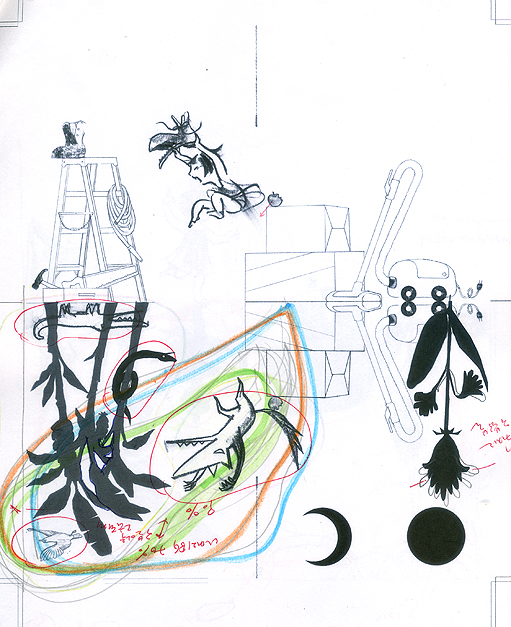
While this can be easily chalked up to an imaginative little child creating puppet shadow figures using a lightbulb – the adult in me relishes the idea of introducing concepts such as befriending one’s shadow, dancing with one’s fears, and comforting our inner monsters by stretching out our hands in friendship. Yes, that is how unspeakably beautiful this shadow of a book is.
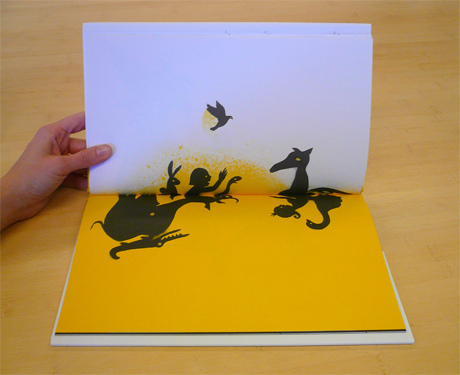
Shadow (Q & A with Suzy Lee)
Suzy, you have once again created a masterpiece with Shadow which I believe is your recent book, tell us, how do these images come to you? What is your creative process like as a fanciful idea strikes you? How do you develop it to a full-pledged book?
“Shadow” is part of “The Border Trilogy” which I mentioned earlier. All three books have different stories but share the same idea – the border of fantasy and reality. I came up with the story for “Shadow” while trying to create the third and last book of the same theme. Some unrelated ideas magically meet each other and become a book. Maybe the theme of shadows was already implied in “Mirror” because they are both reflections of oneself.
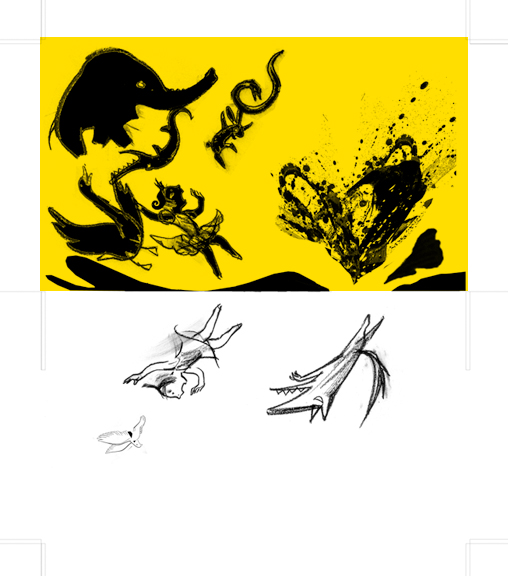
Tell us about Shadow. How long did you make this? What was your inspiration behind the book?
It took about 6 months. After “Mirror” and “Wave”, I wanted to complete the third book as a part of The Border Trilogy. “Mirror” was vertical and opens to the side. “Wave” was horizontal and opens to the side too. So what’s left? Creating the story for the third book was based solely on the book’s form and the way it opened. A book that opens from bottom to top – a top world and bottom world divided by the center binding fold – a play made by a child alone – the child’s creations coming alive… the conclusion came quite easily -“Shadow”.
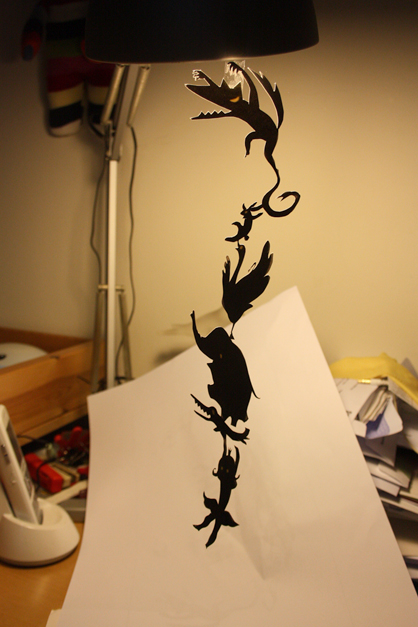
The book review done by Gene Luen Yang entitled Just Over the Page, a Parallel Universe for the New York Times this November 2010, hails this book as further proof of the value of the printed material to downloadable ones via Kindle, iPad or iPhone – what are your thoughts on this?
I am dealing with the books, as you mentioned, specifically “the printed matters”. If I’m making a book anyway, I thought to create a book that is more interesting because it takes the form of a book. In this digital era, a book may feel like a basic and limited medium. However, are things more free without limits? I am more interested in playing with limits.
Shadow can be read in two distinct ways depending on whether one begins with the shadowed-rendering or the supposedly-real black and white depiction on the other side of the book – tell us, which one would you recommend first to your reader – the fantastical side of the book? Or the reality-based one?
I’ll suggest another way. Try to read in portrait-style. You may feel dizzy but you can see both worlds at the same time!

Here, you also played around with tiny clicks of a light bulb and The End not necessarily being The End – tell us a little more about this.
I love the dramatic effect of the sound of clicks. It’s like the spotlight on a stage. The light is on, the show begins. The light is off, it’s dark out, or the show is over. But is the show really over? After the child left the attic, there’s another sound of click and the shadow creatures’ own party starts again. It can be child’s on-going imagination or there exists another world we never know. It’s like a dream within a dream like the Alice book. You woke up from a dream, but that was also part of another dream!

On that note, this is not The End of our Feature of Suzy Lee’s Art Work. Watch out for Part Three as we share with you Suzy Lee’s Animal World (The Zoo, The Blackbird, and La Revanche des lapins) and our feature of her Alice in Wonderland in Part Four of our Suzy Lee Special. Click here to be taken to Part One of our Interview with Suzy Lee as a Book Artist.
If you wish to see more reviews done on Suzy Lee’s books, click here to be taken to a highly incisive blogpost by David Elzey on Mirror and Wave from The excelsior File. For Gene Luen Yang’s article written for the New York Times on Suzy Lee’s Shadow dated 04 November 2010, click here. 7 Impossible Things before Breakfast has also written an enthused review on Mirror as could be found here.
 PictureBook Challenge Update: 42-43-44 of 72
PictureBook Challenge Update: 42-43-44 of 72
Reading the World Update: 4 of 6, Northeast Asia, Wordless Picture Book
PoC Reading Challenge Update: 21/22/23 of 25
Wave by Suzy Lee. Chronicle Books, San Francisco, U.S.A., 2008. Book borrowed from Suzy Lee.
Mirror by Suzy Lee. Edizioni Corraini (Mantova, Italy), 2003. Book borrowed from Suzy Lee.
Shadow by Suzy Lee. Chronicle Books, San Francisco, U.S.A., 2010. Book borrowed from Suzy Lee.

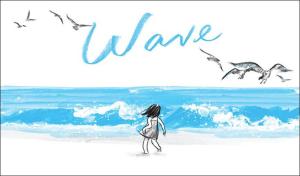
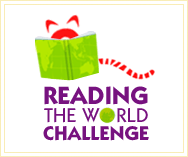

This is definitely a wonderful look into Suzy Lee’s books and artistry. I love that the book itself is part of the experience. The way she looks at the book—its gutter and border—and including it as an element in the actual picture book is wonderful. I do wish its more available to the greater majority.
LikeLike
Amazing is an understatement really. But yes, I echo your sentiments about its limited availability. Hopefully, Suzy Lee’s publishers are reading this and would consider expanding to other countries. I know for a fact that I would be using some of her books in my class.
LikeLike
Wave is one my favorite picture books – reminds me a of the book Flotsam too. Both use the concept of waves to weave an amazing and mesmerizing tale.
If you are interested, do peep into an old review of this book at Saffron Tree
http://www.saffrontree.org/2009/03/wave.html
LikeLike
It does have that similarity with Flotsam in terms of the use of waves. The difference is in the rendering. I find Suzy Lee’s Wave more subdued while Flotsam has an array of colors and elements in each page.
We also did a review on Flotsam as part of our wordless picture book theme, so its interesting that you brought that up. I hope you visit our “Behind the Books” where we we feature Suzy Lee, the Book Artist.
LikeLike
I did visit your review of Flotsam too. I enjoyed it a lot.
Many thanks for dropping by Saffron Tree.
LikeLike
Thank you for dropping by our little nook here. Will definitely check out your review and leave a note as well. While I lovelovelove Wave, I have to admit that Mirror spoke to me even more. You have got to get yourself a copy of that too.
LikeLike
Wow, the art used in all of those books are gorgeous. I love wordless picture books, I found The Arrival by Shaun Tan to be very moving. I’m checking out this review due to the PoC challenge, and I’m glad I dropped by because I’m now adding Suzy Lee to my wishlist!
LikeLiked by 1 person
Hello April, thanks for dropping by. I’ve been quite remiss in visiting other PoC blogposts (it’s a crazy time at the university right now). Would definitely try to check out some of your most recent PoC posts as well.
YES, I have to agree with you about The Arrival. Fats (one of our main contributors here) and I are planning on doing our very first combined post for The Arrival – we find that it’s way too powerful and moving to be done by either one of us, so we shall combine our thoughts and insights in one review, we shall see how that goes.
LikeLike
Oh, I so want to have her books! I love the scene where the girl splashed the water with a kick and the washed out scene as well. The gorgeous blue color really pops out and I am in awe that she was able to really capture the fluidity of water and the power of the waves using charcoal.
I love the surreal quality of both Mirror and Shadows. As a kid I’ve always been amazed at mirrors and thought about how they made it and whoever discovered it, just think if we didn’t have mirrors. Yipes! =) and perhaps there is a world inside it^^. I also remember creating shadows at one point as a kid, making animal shapes with my hands, creating stories along with it. On one hand I will always feel that there is a sinister side to shadows, thanks to the many scary “shadow” related stories I’ve heard and been told. She combined these two sides perfectly making the book for all ages. =)
LikeLike
Hello Tin. Yes, I like that page as well (the kicking and splashing of the waves, showing who’s boss around the shoreline) – such petulance and beauty and innocence of childhood captured.
I have a feeling you’d be moved deeply by Mirror and Shadows. There is a surreal quality to it that speaks poignantly to the adolescent and the young adult (such as ourselves, huh?). I honestly can’t wait for our feature of Alice in Wonderland, although admittedly, that one is quite a heavy-duty theme as well. =)
LikeLike
Thanks for heads up about Suzy Lee! I will be checking out her books!
LikeLike
Hi Chelle. Thanks for dropping by. I’m glad you enjoyed the post. =)
LikeLike
Pingback: Reading in April’s Heat: An April Round-up |
Wow…breathtaking art, story…interview, feature! Thank you so much for this. Will be ordering all three of these books for our collection, for all library patrons, but one of my book club members in particular. She is an aspiring artist and illustrator (9 years old), what a thrill to show her what you can tell with out words.
LikeLike
Hi Deb! Thank you so much for dropping by and visiting our site. I’m glad that you enjoyed this one. Do let me know how it goes once you have the books with you and how the kids would take to it. =)
LikeLike
Pingback: The 2011 Reading Challenge Round Up |
Pingback: AFCC Update 5: Love to Suzy Lee «
Pingback: Ministry of Education HeadQuarters Library Exhibition in Singapore «
Pingback: [Monday Reading] Finalists in Cybils Fiction Picturebook |
Pingback: [BHE 183] Singapore Library Warehouse Sale 2015 | Gathering Books
Pingback: [Monday Reading] Seven Picturebooks about Books Published in 2016 – Gathering Books
Pingback: Love For Monique Felix’s Wordless Mouse – Gathering Books
Pingback: [Monday Reading] The Promise Of Tomorrow And Another in 2019 Picturebooks – Gathering Books